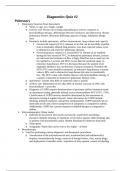Case
NSG 550 Diagnostics Study Guide Quiz #2.
- Course
- Institution
Diagnostics Quiz #2 Pulmonary Pulmonary Function Tests/Spirometry o Varies w/ age, sex, height, weight o Used to eval: Preop eval of lungs and pulmonary reserve, response to bronchodilator therapy, differentiate between restrictive and obstructive chronic pulmonary disease, determine diff...
[Show more]



